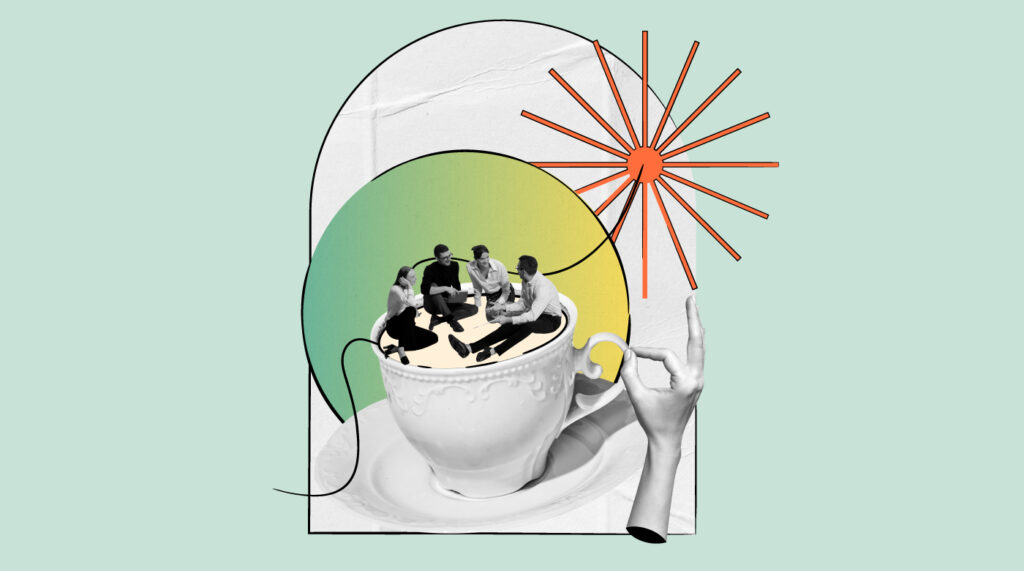“You know this isn’t going to make a difference, right?” One of my team members challenged me as I signed off the budget to provide each of our 350+ employees with a $200 ‘wellness stipend’ to spend on activities to improve their physical or mental health.
As Chief People Officer of a global marketing agency, one of my biggest challenges was ensuring people felt supported as we navigated the challenges caused by the pandemic and the intensity of agency life.
Over the years, we’d focused on creating a fantastic culture, but the Best Place to Work awards we’d won over the years didn’t give us immunity to these new challenges as people reassessed what they wanted from life and adapted to new pressures and ways of working.
For a period, we saw increased attrition and more mental health leaves. Employee surveys reminded us that many felt disconnected from work and each other.
While providing people with a personal well-being budget went down well, I wasn’t under any illusion that it would fundamentally counter these issues or improve employee mental health.
Our situation was far from unique.
In 2022, Gallup reported that 60% of workers worldwide are ‘emotionally detached at work’. We continue to hear about the 'great resignation' and ‘quiet quitting’—a term that describes employees reducing the effort they put into their jobs.
Studies show that nearly 81% of workers face some form of burnout or mental health issue with 68% of employees saying their daily work has been interrupted by these challenges. Deloitte estimates that poor mental health costs UK employers up to £56 billion annually.
In 2021, Mindshare Partners shared the grim news that 68% of Millennials and 81% of GenZers have left their roles for mental health reasons. Employees are rightly demanding more from their employers, with 91% of US workers now believing that a company’s culture should support mental health, up from 86% in 2019.
Given the profound human impact and phenomenal cost to businesses, leaders must develop proactive strategies to support their people. Over the last few months, I’ve spoken to 50+ CEOs, MDs, Chief People Officers, and HRDs. All recognize the forces impacting their people and businesses. None have got it all figured out!
Some are taking a holistic approach to building a mentally healthy workplace and are making meaningful progress. Most are feeling overwhelmed at the scale of the challenge, and have implemented a range of initiatives but don’t know what’s making a difference and what’s not.
A minority acknowledge that their efforts are purely performative, with their marketing teams encouraging people to switch off on Mental Health Awareness Day, or simply training a couple of people to become Mental Health First Aiders and sticking their faces up on a sheet of paper next to the office coffee machine. This chimes with a recent Aon survey which found that less than half of UK businesses have a comprehensive well-being strategy.
Over the years, I’ve worn all of these hats. From not knowing where to start, to launching various initiatives under the banner of supporting mental health in the workplace, to learning to think much more coherently about how well-being needs to be baked into organizational culture.
Some of what we tried made a real difference. Some didn’t. Some had a short-term boost but didn’t sustain impact over time. Honestly, I couldn’t always say which was the case as I didn’t always make it a priority to assess impact.
I don’t have all the answers but, with the benefit of some distance now I’ve left my CPO role, I’ve been able to reflect on what I got right and the mistakes I made. I’ve distilled this down into 4 principles which aim to help leaders grappling with the significant challenges impacting their businesses and people.
The examples I share are not intended as ‘best practice’ as much as stories to spark ideas for how you might apply these principles to help safeguard mental health in the workplace.
1. Work to measure impact
While studies have found that investing in employee mental health can offer a real return on investment (ROI) only 3 in 10 UK employers have a designated budget for health and wellness.
Out of those, less than 1 in 10 actively measure ROI of their well-being programs. This means that the majority of HR teams are having to build the investment case, raid other budget pots, or figure out how to drive change without spending money. Sadly, we all know which budgets tend to be cut during economic downturns. Life doesn’t get any easier for already beleaguered People Teams.
I wish I'd been more disciplined about evaluating the different programs we ran. Understanding how many people were actually using our Employee Assistance Programme (which provided people with access to free therapy) was always a challenge.
The resilience speakers we brought in shared fantastic advice, but we didn’t know whether anyone changed their behavior as a result of listening. That wellness stipend… well, we knew how many people spent it, but not whether it improved how they were feeling.
Don’t get me wrong, I’m sure the combined impact of all of these activities contributed to a more supportive culture, but the lack of impact data did make it hard to know what to do when budgets got cut or more money became available.
It was easier to decide to reinvest in a program we had piloted when we had tangible impact data that showed significant improvements in the well-being and connectedness of participants.
So whatever you’re doing, take the time to figure out what’s actually working:
- Don’t just measure how many people show up to the presentation, but follow up a couple of weeks later to see if anyone is doing anything differently as a result. A simple email (with just 1-2 questions to make it easy for people to reply) does the job.
- Look at whether employee engagement metrics shift after you introduce new initiatives.
- Look at behavioral data, too. Is there a correlation between participation and retention? Are programs reducing absence or sick days?
- If you’re working with external partners, ask them to share evidence with you that proves their programs work and sustain impact over time.
- Share this data with whoever’s signing off budgets and don’t be afraid to stop doing what’s not working and double down on what is!
2. Utilize your company’s existing eco-system to avoid overloading people
‘Not another company initiative?!’ — Frustrated workers around the world bemoaning employers asking them to take part in well-intentioned initiatives which compound rather than alleviate the issues they’re trying to solve.
I definitely struggled with this. It’s easy to get carried away by launching too many initiatives and overwhelming people. We started to make more progress when we used our company’s existing infrastructure to amplify our well-being strategy. Two things proved particularly effective:
2.1 Repurposing existing time for activities to support well-being rather than asking more of people.
We’d repurpose a recurring team meeting to swap stories on how we were all dealing with what was going on in the world. We took over an all-hands meeting and gave everyone money to go for a coffee to build a relationship with someone they didn’t work with every day.
We also launched ‘Focus Fridays’, clearing people of client and internal meetings to give them time to do deep work. Fridays also provided time for people to take part in more extended learning and development, such as a four-week program to train people in therapeutic talking and listening skills.
2.2. Use your company values to encourage desired behaviors
Most companies will have a set of corporate values. Looking at these with a fresh lens offers ripe territory for ideas to support employee well-being.
One of our company values was ‘Show The Love’, a reminder to be kind to others and take time to celebrate progress. We redefined the behaviors linked to ‘Show the Love’ to remind people to also take care of themselves.
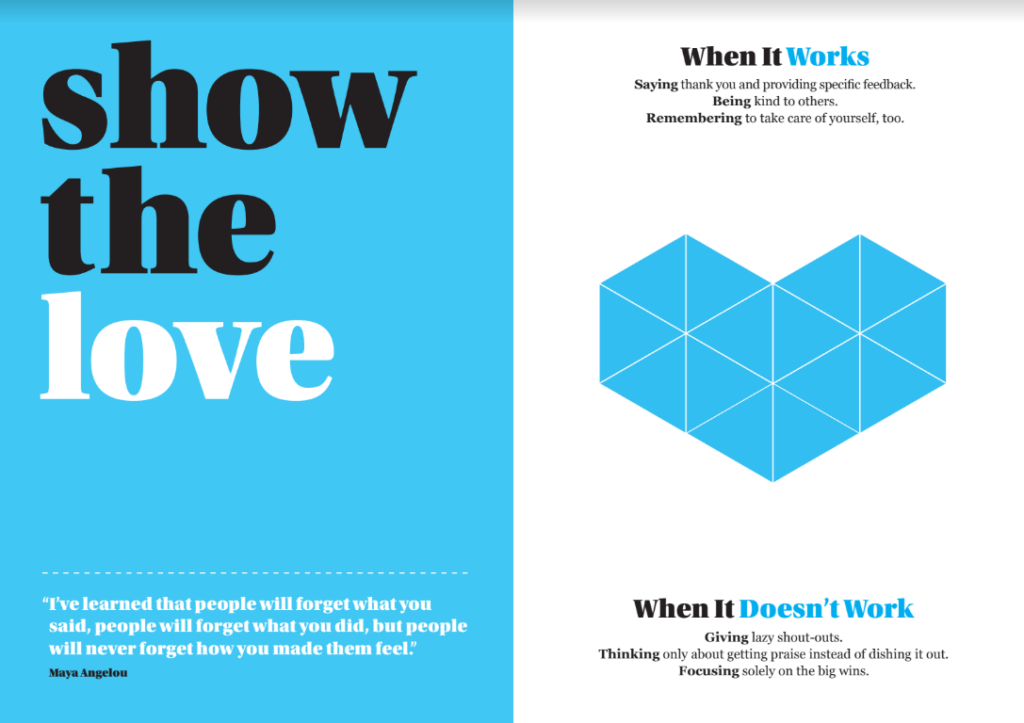
Another of our values was ‘We Before Me’, a push to focus on the team and step in to help others when needed. We were proud of this aspect of our culture but came to recognize that any positive behavior taken to an extreme can have negative consequences.
We heard from people that overly focusing on ‘we before me’ could lead to people sacrificing their own well-being to serve others. We reframed this value, stressing that ‘We Before Me’ was not about ‘solving people’s problems for them’ or ‘having no personal boundaries’.
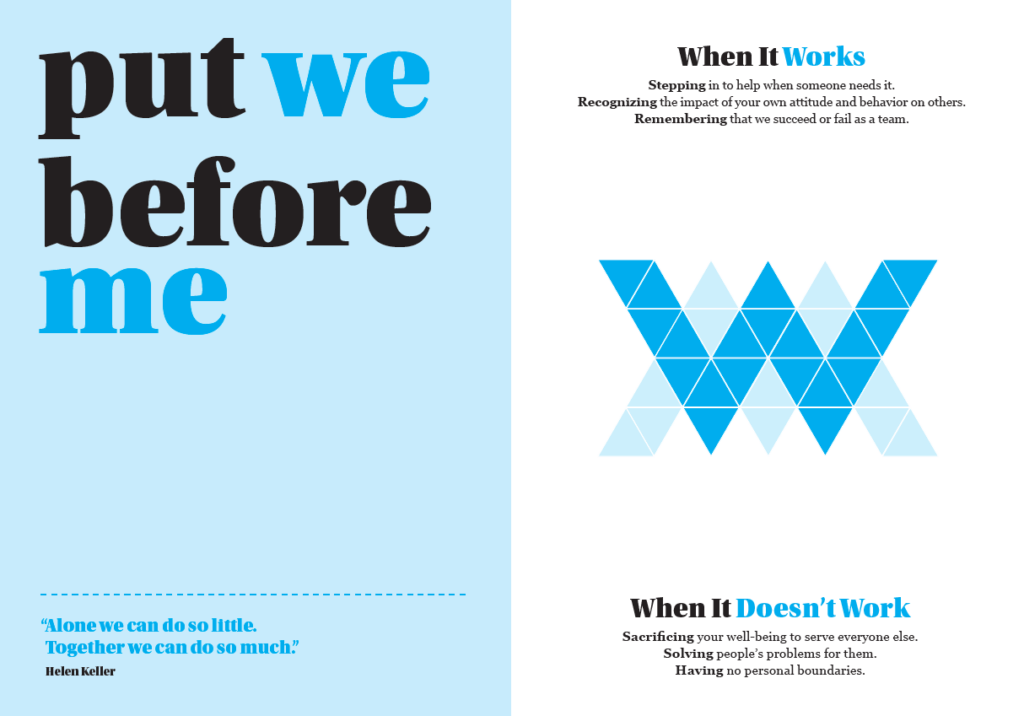
We also gave everyone in the company a ‘Me Day’ so they could take an additional day off and expense a small amount to do something meaningful to them. We encouraged people to share stories and photos on social media to inspire others to take part.
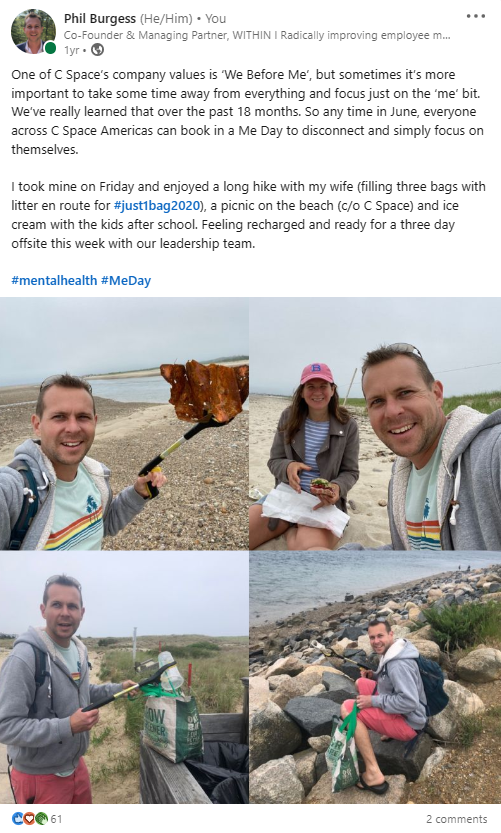
While this refocusing of our values didn’t change everyone’s behavior, it shifted the paradigm for many, and we saw more people truly switching off during vacations and drawing clearer boundaries around their working day.
3. Focus on activities that proactively strengthen the collective, rather than reactively ‘fix’ individuals
It’s easy to fall into the trap of focusing on solutions that remedy individual ill health—promoting access to free therapy sessions available through an employee assistance program, asking people to talk with a Mental Health First Aider, teaching resilience skills which put the onus on the individual to change their behavior.
These reactive ‘fixes’ are an important part of the mix, but they fail to tap into a major driver of positive mental health: the power of the group.
There’s a wealth of evidence that demonstrates that social interconnectedness, and the quality and strength of the relationships that we have with co-workers, has a powerful influence on our physical and mental health.
US Surgeon General, Dr. Vivek Murthy, noted “creating stronger connections in the workplace matters. Connections which are the most meaningful are those when we feel we are seen and understood by another person, where we feel we can truly be ourselves.” Bruce Daisley sums it up nicely in his book, ‘Fortitude’, concluding that ‘true resilience lies in a feeling of togetherness’.
With this in mind, many of our most impactful programs were fundamentally about driving connection, as we tried to mitigate the sense of isolation many felt through increased remote working and a reduction in the serendipitous encounters in the office that enabled people to build connections outside their day-to-day teams.
A couple of ideas that worked well for us that might work for you:
3.1 A mental health & connection program
We partnered with the social enterprise, Talk For Health, to take 50 members of our team through a group-based program that scaled the benefits of therapeutic talking.
Participants developed empathic talking and listening skills and were trained to set up and run their own ongoing groups.
It led to significant well-being improvements (measured using the WHO5 scale), reduced depressive symptoms, and strengthened relationships across teams, offices, and geographies.
In fact, participating in this program myself, and seeing the impact it had on people, was what inspired me to leave my CPO role and start a business in this space.
3.2 Humanizing the team for new joiners
One of our departments grew significantly during the pandemic, but because team members were spread across various different locations new starters reported that they were feeling lost. To counter this, the team created a simple Welcome Pack which was sent to all new joiners.
Each team member contributed a slide sharing their story and a photo of who they were, not just their job title and position on the org chart. In their first week, new starters received the pack and added their own slide to the deck.
It cost nothing and, interestingly, that team experienced the lowest level of attrition and highest employee engagement scores across our company. They also had the highest annual revenue growth!
While I’m sure this deck alone wasn’t the driving factor, it’s illustrative of the approach that the team leader took to making time and space for intentional relationship building.
4. Embrace the power of role modeling to shift culture
53% of C-Suite executives have said they struggle with mental health issues. It can be incredibly powerful in reducing the stigma about talking about mental health at work if senior people in your organization speak openly about their personal challenges.
True, there’s a line to be walked between sharing and over-sharing, but I received incredibly positive feedback from people when I started being open about my own challenges.
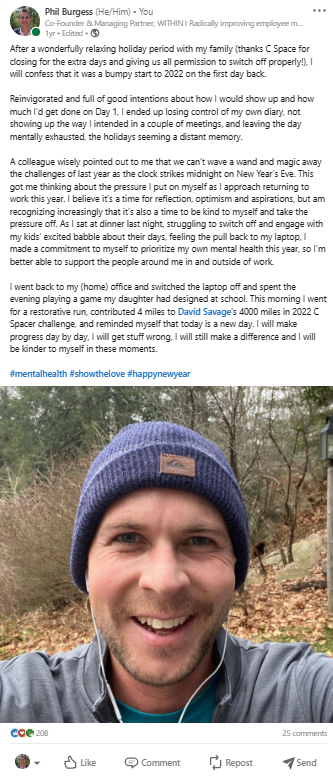
I remember sharing in a staff meeting that there were a couple of times during the pandemic when I had broken down in tears at my desk at the end of an exhausting day. It was an exposing moment for me, but my instincts told me it would create permission for others to be vulnerable if they knew that senior leaders were struggling too.
Role-modeling positive behaviors you want others to emulate can go a long way to building a more mentally healthy workplace:
- Encourage leaders and managers to create boundaries around their working day
- Ask senior leaders to openly share when they’re taking a ‘mental health day’ to recharge, or leaving early to prioritize a kids’ play or sports event
- Encourage people to stop sending emails when they’re on vacation, or when they’re off sick.
In my experience, you’ll never get everyone on board with this, but those that do it will create permission for others to do the same.
Part of my own self-care strategy is getting out in the fresh air for a walk or a run. I’ll often pick up litter at the same time. I’d do 121 phone calls while on a walk, allowing both of us to escape our computers, and then I’d post about it on LinkedIn or our staff chat channels to encourage others to do the same.

If I was working from home, I’d go for a run during an all-staff meeting when I didn’t need to see my screen and then speak up at the end, slightly out of breath, to let people know I’d been making space for exercise during my day.
Thinking intentionally about how I could be a good role model was great for my own mental health, and also helped me deal with my personal tendency to want to rescue people.
I learned that part of my role as a leader was to create the right environment to empower people to adopt behaviors to support themselves.
Wrapping up
I hope that these principles and reflections have sparked your thinking around how you can support your people and develop a culture that supports employee wellbeing.
Some argue that mental health initiatives are not the right way to build sustainable and mentally healthy workplaces; that they distract leaders from dealing with the systemic issues which impact mental health in the workplace—having a good manager, a clear sense of purpose, being treated equitably, and feeling like you belong.
We worked consciously on all of these things too, but they’re complicated and take time to get right. Even the world’s best organizations aren’t perfect, and in an increasingly complex, ever-changing world that constantly surfaces new challenges for the people who work in and lead our organizations, the work is never done.
In a world where these problems no longer exist, perhaps the need for workplace mental health programs will be reduced. I hope so. But I struggle to see a world where leaders don’t need to invest intentionally in ways to improve mental health if they’re serious about creating high-performing, supportive organizations that people want to work for.
There is definitely a risk of well-being initiatives becoming performative, tick-box exercises that don’t make a difference if they’re not integrated into other tenets of a company’s people strategy.
The opportunity (and challenge!) for leaders is to ensure their strategies for supporting employee mental health are linked to the very ‘real work of culture change’ so that they ‘move from seeing mental health as an individual challenge to a collective priority’.
Please reach out in the comments with any questions or ideas.
Some further recourses:
- How To Identify, Pre-empt, And Deal With Workplace Burnout
- 10 Best Employee Wellness Platforms For Employee Health & Well-Being
- Improving Work-Life Balance While WFH: 12 Tips For Teams And Orgs
- How To Create A Mental Health Strategy That (Actually) Works
- How To Create Suicide Safer Workplaces
Subscribe to the People Managing People newsletter to receive regular content to help you progress in your career and build healthy, productive organizations.

